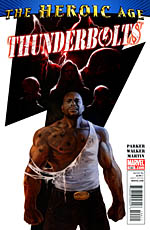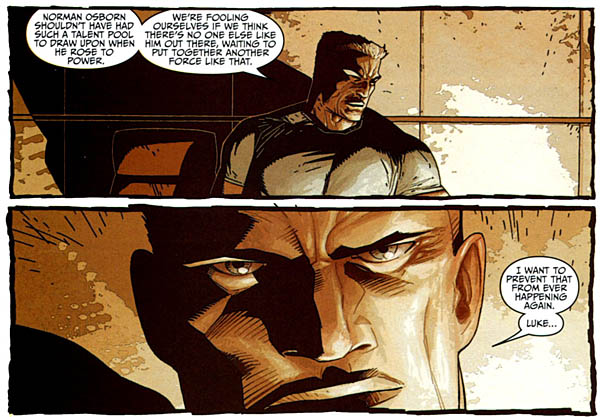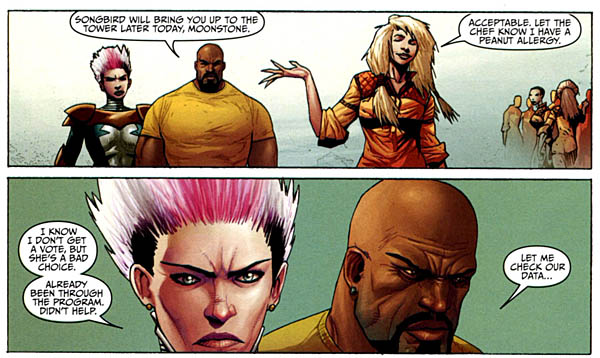 Written by Jeff Parker
Written by Jeff Parker
Art by Kev Walker
32 pages, color
Published by Marvel Comics
When Kurt Busiek and Mark Bagley created Thunderbolts some thirteen years ago, they might not have imagined that their book would be one of the few new ongoing franchises at Marvel that would prove to have enough power to stick around. It was a sharp enough concept—villains pretending to be heroes—that even with minor tweaks along the way it’s kept going. Jeff Parker, the book’s latest writer, came on board a few months ago to wrap up the "Dark Reign" era of the title, and usher in the next incarnation of the title. So far? I think this is probably my favorite take on the title since those original Busiek and Bagley issues.
Parker’s writing Thunderbolts as a mix of several previous incarnations of the title. It’s run out of Marvel’s super-powered prison, the Raft, and features Luke Cage and several former Thunderbolts working with a new team of villains to try and rehabilitate them through serving on the team. It’s the sort of high concept that is hard to swallow in the real world, but within the confines of the Marvel Universe somehow seems acceptable. Parker pushes Captain America front and center to deliver the exposition explaining why this sounds like a good thing, and it comes across as a reasonable enough option that you’re nodding your head within a manner of pages. I think that’s the greatest strength of Parker’s writing in Thunderbolts #144; there’s something about the way he presents everything that you find yourself going along with it.

Parker devotes this issue to assembling his new cast of characters, leading us to each one in turn as they’re told that they’ve made the cut for the new Thunderbolts roster, and letting us see not only their reaction but also the feelings of new leader Luke Cage and his support staff. It evokes images of those old caper films, where one by one another member of the team is recruited and we learn about their specialty and why they’re absolutely necessary to break into that bank vault. Of course, in this case we aren’t learning so much about skills in cracking combination locks, but rather wondering if this is a person that’s on the fence about giving up their old ways, or if Cage and company need to watch their backs whenever they’re around the Juggernaut or Crossbones. The flashback panels with Cage reacting to his new squad provides a nice balance to when we see Cage talking to them individually, and it’s enough of a mix that you want to see more.
Kev Walker takes over the art with this issue, and I can already tell that he’s going to evoke strong reactions one way or the other from readers. After a page or two, I found that I liked his rough-hewn figures, rocky-faced characters. It’s definitely a different look for some regular faces at Marvel Comics; Captain America looks much older and more craggy than I’m used to, and Songbird’s new spiky hairstyle is a sharper, harsher look than she’s been sporting for most of the last decade or so. What ultimately sold Walker’s art for me, though, was the way he draws Luke Cage. He’s a mountain of a man here, rock solid power just radiating from his form. He looks menacing without being mean, and like a real figure of authority. It’s exactly the right look for Thunderbolts.

Walker draws his pages in columns of horizontal panels, stacked one over the next. You might expect it to be limiting, but I think it’s to Walker’s credit that it never comes across that way. Just like a movie camera, Walker uses the long horizontal view to zoom in our pull out at just the right moments, and control the reader’s viewing of the scene. Up until the end, the only variation we get are jagged edges for panels that are flashbacks, a simple tool that lets Parker avoid having to slap too many captions onto the comic and segue between the two easily. When Walker finally does mix up the page layout at the end, the added benefit is that it feels dramatic and different; all the structure has come tumbling town, just like the Cage’s carefully constructed plan. It’s a nice touch, and a sharp way to close out the first issue of the book’s new direction.
Thunderbolts #144 grabs the reader’s attention, but just as importantly, it’s fun. This is a book that’s been rather grim the past few years, so it’s nice to see Parker and Walker able to find even a little bit of joy in a group of bad guys and their caretakers. I think old and new Thunderbolts fans will have something to draw them back in; I know I want to read more. This is a great start to what will hopefully be even more fun to come.
